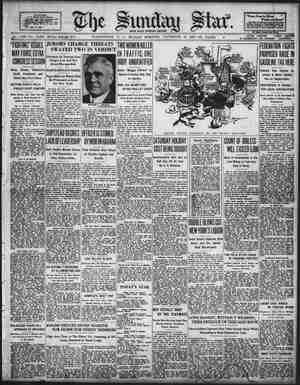Evening Star Newspaper, November 16, 1930, Page 101
You have reached the hourly page view limit. Unlock higher limit to our entire archive!
Subscribers enjoy higher page view limit, downloads, and exclusive features.
THE SUNDAY STAR, WASHINGTON, ‘' D. C; NOVEMBER 16, 1930. . A ‘Changing the Clothes on Caruso’s Corpse T'he-Great Tenor’s Body Now Embalmed With the Scien to Popes and Princes Only, Why and How the Burial Changed Are Given BY IRENE DI ROBILANT. NAPLES, Italy. OT many months ago the well known singer Tito Schipa gave an interview concerning the late En- rico Caruso which caused something of & sensation among the still numerous Caruso “fans,” while it came as & veritable shock to the late singer’s family entirely without foundation, especially as Mr. Schipa had been quoted as stating that he F 1 555 hi 1 i i g ; ! i, i £ BT ,Jgiésigg;%figi;z il ! § I Hills i i : i Caruso, great artist that he was, by nature a sunny and wholesome Neapolitan boy. The above portrait was made shortly before his death in 1921. g reach of medical care, but sudden and unexpected death came to put an end to the singer’'s momentous life. Such are the facts of the ending of a great life Caruso’s will was comparatively old and left no other in- structions concerning his burial than the desire of being laid to rest in the city of Naples, where he was born, and being buried according to the rites of the Roman Catholic Church, of which he was a communicant all his life. Mrs. Caruso, an American by birth and a member of a well Rests Peacefully in Naples, tific Skill Given Ordinarily and the Trueft acts About Clothes Are Periodically Here for the First Time. known New York family, desired his body to be embalmed, not only because the procedure is almost universal among Ameri. cans, but because she thought that little Gloria might want te look some day upon her father's face, when old enough te realize both her loss and the great fame which he had enjoyed Although the desire seems quite natural in her case, ff aroused some comment-in Italy, where embalmment is not very general. The process is used for the bodies of Kings as for the Popes, and extraordinary scientic ability has been for the preservation of the relics of saints, once the ch recognizes their merits and recommends public veneration, in a general way the costly procedure does not enter undertaker’s duties and is regarded as somewhat prof: Catholics, as if the artificial preservation were in con the words, if not the spirit of the ediet, “Dust thou «it, to returneth.” Anyway, Caruso, & good and devout Catholic and a bene of the church, was buried according to the traditional rites, those who atiended the funeral were amazed at the ability which Neapolitan undertakers had preserved the lifelike appear. ance of the body, which was dressed in evening clothes, as it customary for a citizen of weelth, and lay in the glass-covered coffin with the appearance of natural sleep. It may be of interest to note that the members of ths scientific institute of Naples who were commissioned to do the embalming transmit to one another for scientific purposes the secrets of a method of petrification said to be very old and almost perfect, and to have come to the N schools by the way of the Greeks, who, in their turn, had learned it from the Egyptian mummy makers. : : §EE§!§ ] gt tsf CARUSO'S bier was iaid in the white marble sarcophaguy which Canessa had copied from an Italian model, and which stands within the chapel. Always with thy thought of little Gloria in mind, not only way, the coffin closed with a crystal lid, but th, sarcophagus was made with a panel which could be easily removed, allowing visitors t, look upon the dad man’s face. » Considering that Enrico Caruso’s memory 1 a real and living thing, thanks to the record which have preserved the thrilling power of hiy voice, it seems strange that people should want ggéffa # i P i i £ 25 1l o i {lr i L g fe § gk ¥ & F
